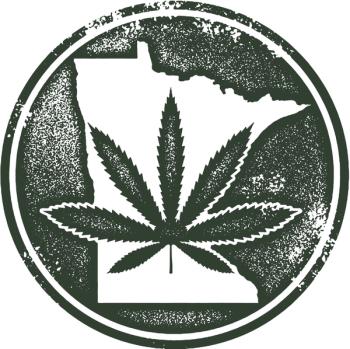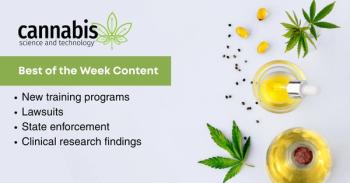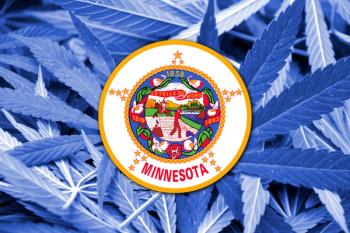
Is Cannabis a Solution to the Opioid Crisis?
In this research overview, Ruth Fisher, PhD, explores how cannabis has shown promise in helping individuals reduce opioid use, potentially decreasing overdose deaths. Though its impact on chronic pain and opioid reduction remains evident, limitations exist and flaws in methodologies in ecological studies complicate conclusions.
There is clear reason to believe that cannabis should be an important therapeutic for helping many people decrease their use of opioids, potentially leading to fewer overdose deaths. Yet, there are a few potential hazards that should be emphasized, as well as flaws in the methodologies of some of the research that should be addressed.
Cannabis May Decrease Opioid Use
Let’s start with the research in support of cannabis as a solution to the opioid crisis.
Mechanisms of Action
Opioids are pain killers. They activate opioid receptors in the brain, which block pain signals between the brain and the body (1).
There’s a rich body of literature discussing the potential mechanisms of action by which cannabis helps address pain (2). There’s also a large body of research examining interactivity between the endocannabinoid and opioid systems. In particular, cannabis and opioids have a bidirectional, synergistic relationship. This enables users to achieve similar, if not improved, analgesic effects by substituting some or more opioids for cannabis (3). There are also several clinical trials examining the use of cannabis to help patients either reduce their use of opioids (4-8) or address opioid use disorder (9- 12). There’s thus a clear academic basis for using cannabis as a substitute for opioids.
Patients Are Using Cannabis as a Substitute for Opioids
Next, as far as what patients are actually doing in practice goes, most surveys suggest that a substantial portion of people use cannabis at least in part to help address medical issues (13-15), and most surveys suggest that the first or second most prevalent application of medical cannabis is to treat pain (16- 18). Furthermore, many surveys report that people who use cannabis to treat pain end up decreasing, if not eliminating, their use of other pain medications, including opioids (18- 20). Cannabis users report substituting cannabis for opioids as a harm reduction tool, because cannabis, either alone or in conjunction with lower doses of opioids, provides better pain relief, while generating fewer side effects, and offering a better quality of life than opioids (19-20). There is thus a clear real world basis for expecting that cannabis use has already decreased the use of opioids.
Ecological Studies Show Cannabis States Have Fewer Opioid Deaths and Prescriptions
Finally, multiple studies comparing states that have legalized cannabis activity with those that have not have reported that states with legal cannabis activity have experienced substantially (i) fewer opioid overdose deaths (21-22), (ii) fewer opioid prescriptions (23-24), and (iii) fewer drug prescriptions for medications that address the same conditions as cannabis (25). The substantial reported reductions in opioid deaths, on the order of 20%, and prescriptions, on the order of 5% - 10%, have been particularly sensational.
Objections to Cannabis as a Substitute for Opioids
Now let’s address the criticisms to the rosy picture being drawn by advocates of the cannabis solution to the opioid problem.
Cannabis May Stimulate Opioid Use
First, as with any therapeutic, there are potential limitations. In particular, stimulation of cannabinoid receptors “has profound effects on the rewarding properties of opioids” (18), so that using cannabis may lead users to increase, rather than decrease, their use of opioids. Studies have shown this to be the case, that using cannabis has led some people to subsequently increase use of opioids (26). Also while there’s a potential for cannabis to decrease opioid withdrawal symptoms, there’s also a potential for cannabis to increase such symptoms. Researchers have posited that these differences across cannabis users in the impact of using cannabis on subsequent opioids use or on opioid withdrawal symptoms may depend on differences in users’ endocannabinoid systems and/or in the makeup of particular cannabis products (18).
Ecological Studies Are Not Accurate
There are methodological problems that call into question the accuracy of studies alleging that there have been substantial drops in opioid prescriptions and overdose deaths in legal cannabis states relative to those in non-legal states. These types of studies that consider the relationship between population level outcomes (i.e., overdose deaths and prescription rates) for states that have legalized medical and/or recreational cannabis activity vs. states that have not are called ecological studies (27).
Ecological Studies Cannot Link Cannabis and Opioids for Individuals
The strength of ecological studies is that they enable researchers to investigate outcomes at the population (i.e., state) level to get a bird’s eye view of what’s happening at large scale. The problem with these types of studies, though, is they cannot see how the issue being studied, in this case legal cannabis activity, affects individuals. In fact, trying to infer “individual-level relationships from relationships at higher levels of aggregation [has] became known as the ‘ecological fallacy’” (28). In the case at hand, ecological studies of how cannabis laws affect opioid use cannot link uptake of cannabis use by a particular individual to decreases in opioid use by that same individual. It could thus be the case that people who use cannabis to treat chronic pain are a different group of people from those who use opioids, in which case any decreases in opioid use subsequent to the legalization of cannabis may have nothing to do with the availability of cannabis.
Ecological Studies Don’t Account for Other Changes in the Environment
Furthermore, ecological studies cannot account for other changes in the environment – either in the country or in specific states – that were occurring during the period of the study. Without accounting for changes in the environment, we cannot be sure that changes in opioid deaths and/or prescriptions were due to cannabis laws, rather than some other changes that were occurring during the time the studies were conducted. In fact, there were several important events during the past decade and a half relating to the supply of opioids that could have led to the decreases in opioid use and overdose deaths reported in the studies. Specifically,
- In 2009, the American Pain Society and the American Academy of Pain Medicine issued two sets of national guidelines for appropriate opioid prescribing in chronic pain management (29).
- In 2010, OxyContin was reformulated in an attempt to decrease the potential for abuse (30).
- In 2016, the Surgeon General issued a warning letter about the opioid crisis (31).
- 2016 CDC Guideline for Prescribing Opioids for Chronic Pain (32).
No doubt, these changes in the prescription environment played a substantial role in the peaking of opioid prescription rates in 2012, with subsequent decreases ever since (see Figure 1).
Ecological Studies Don’t Account for Cross-States Differences in Policies and Culture
Every state experienced a drop in opioid prescription rates between 2019 and 2022, but the rates of decrease varied across states (see Figures 2 and 3).
While the nationwide policies just discussed are presumably responsible for at least some of the overall drop in national prescription rates seen in Figure 1, other policies that differ across states may have contributed to the differential decreases in opioid prescription rates seen in Figures 2 and 3. Specific policies regarding the prescribing and use of opioids that vary across states in the nature and extent of implementation include, for example:
- Good Samaritan laws, providing legal protection to individuals calling for help in the event of an overdose
- Prescription drug monitoring program (PDMP) laws, requiring prescribers to check the PDMP database prior to prescribing an opioid)
- Naloxone access laws, enabling prescribers to authorize pharmacists to dispense naloxone without an outside prescription or permitting first responders to carry naloxone
- Regulations establishing increased state oversight of pain management clinics
- Access to methadone- and buprenorphine- assisted treatment for opioid dependence
- Extent of imprisonment of opioid users
Granted, many of the researchers attempted to account for some differences across states in certain opioid related policies (21- 24). At the same time, however, there are state-specific cultures (22) and other policies that researchers did not control for that most likely impact opioid overdose deaths (33). In particular, ecological studies rely on the assumption that the factor distinguishing the populations being studied (i.e., whether or not states have legalized cannabis activity) is not correlated with the outcomes being measured. Yet, this assumption does not hold here. That is, cannabis legalization laws were not “randomly assigned to states” (24). Rather, certain policies that are likely to decrease opioid use and abuse, such as access to treatment for dependence, are also more likely to be passed in states that have legalized cannabis activity. Conversely, policies that are likely to exacerbate opioid use and abuse, such as imprisonment for use, are more likely to be passed in states that have not legalized cannabis activity (34). It’s thus quite possible that the differences in opioid deaths and prescription rates between states with and without legalized cannabis found in the ecological studies are due to the different cultures and policies between the two sets of states, rather than to the availability of cannabis.
Cannabis Patient Counts Are Too Small to Account for Large Changes in Deaths and Prescription Rates
In response to the claims by some researchers that legal cannabis states experience on the order of 20% fewer opioid overdose deaths and 5% - 10% fewer opioid prescriptions as non-legal states, Shover 2019 observe that “Medical cannabis users are about 2.5% of the population, making it unlikely that they can significantly alter population-wide indices.”
It’s true that state counts of medical cannabis users, even at peak populations (medical cannabis patient counts tend to decline after states legalize recreational cannabis activity), comprise only a couple of percent of the population (34). However, the counts of patients who are registered in state medical cannabis programs vastly understate the actual numbers of patients using cannabis for medical purposes. Most medical cannabis users are not registered with the state under medical cannabis programs. Rather, the cannabis they consume comes from recreational dispensaries, unlicensed sources, friends and family, and/or home-grown supplies (35).
Furthermore, when considering the impact of cannabis on opioid use, the appropriate point of reference should not be medical cannabis patients counts but rather counts of people with chronic pain, together with the portion of people with pain who use cannabis to treat their pain. According to the CDC, “In 2023, 24.3% of adults had chronic pain…”(36). A 2023 survey of 1,661 adults in the US with chronic pain found that “31.0% … reported having ever used cannabis to manage their pain; 25.9% reported using cannabis to manage their chronic pain in the past 12 months, and 23.2% reported using cannabis in the past 30 days” (37). So then if about 26% of people with chronic pain – the primary users of opioids – reported using cannabis in the past year, and if, say, half of these users reduce their opioid use due to cannabis, then opioid prescription could fall by roughly 13%. In other words, there’s every reason to believe that opioid prescriptions could substantially decrease due to substitution of cannabis for opioids by people with chronic pain. And these figures don’t account for the real possibility that survey respondents may very well have under-reported their cannabis use, due to the morally and/or legally questionable nature of cannabis. In that case, the 13% estimate might actually be an understatement.
Conclusions
Researchers have clearly established mechanisms of action by which cannabis helps address pain and may be used as a substitute for opioids in treating pain. Meanwhile, surveys have established that a large portion of people suffering from chronic pain have actually used cannabis to treat their pain, and in so doing, have decreased their use of opioids. It is therefore reasonable to conclude that the greater availability of cannabis in recent decades has decreased opioid prescriptions, if not also opioid overdose deaths.
While several studies have shown that states that have legalized cannabis have experienced substantially fewer opioid prescription and overdose deaths, these studies have serious flaws which may cause their reported estimates to be inaccurate. Nevertheless, the substantial size of the population of individuals with pain who use cannabis to treat their pain, together with their reported associated decreases in opioid use cannot be denied. It follows that while studies attempting to quantify the impact may be flawed, there must nevertheless be an impact, and quite likely a substantial one.
At the same time, the fact that many chronic pain sufferers have achieved beneficial effects with cannabis also does not negate the fact that other people suffering from chronic pain may not fare so well with cannabis. Cannabis has been shown to lead some users to increase, rather than decrease, their use of opioids or their opioid withdrawal symptoms, demonstrating that cannabis is clearly not for everyone.
References
- Opioids. Johns Hopkins Medicine.
https://www.hopkinsmedicine.org/health/treatment-tests-and-therapies/opioids - See, for example, Manzanares, J., et al. Role of the Cannabinoid System in Pain Control and Therapeutic Implications for the Management of Acute and Chronic Pain Episodes. Current Neuropharmacology. 2006.
https://pmc.ncbi.nlm.nih.gov/articles/PMC2430692/pdf/CN-4-3-239.pdf - See, for example, Wiese B and Wilson-Poe AR, Emerging Evidence for Cannabis’ Role in Opioid Use Disorder. Cannabis and Cannabinoid Research. 2018.
https://www.liebertpub.com/doi/epdf/10.1089/can.2018.0022 - Do Discounted Vouchers for Medical Cannabis Reduce Opioid Use in Adults With Pain. Vireo Health.
https://clinicaltrials.gov/study/NCT04495725 - Does Medical Cannabis Reduce Opioid Use in Adults With Pain. Albert Einstein College of Medicine.
https://clinicaltrials.gov/study/NCT04308148 - MEMO-Medical Marijuana and Opioids Study. Albert Einstein College of Medicine.
https://clinicaltrials.gov/study/NCT03268551 - Evaluation of Medical Cannabis and Prescription Opioid Taper Support for Reduction of Pain and Opioid Dose in Patients With Chronic Non-Cancer Pain. Massachusetts General Hospital.
https://clinicaltrials.gov/study/NCT04827992 - Cannabis for Opioid Substitution Trial. Cannabis Research Associates.
https://clinicaltrials.gov/study/NCT03859089 - Cannabis and Opioid Use Disorder. University of Kentucky.
https://clinicaltrials.gov/study/NCT05729932 - Reducing Pain and Opioid Use With CBD. University of Colorado.
https://clinicaltrials.gov/study/NCT05299944 - Evaluation of the Interactions of Cannabidiol (CBD) With Morphine. NIDA.
https://clinicaltrials.gov/study/NCT05143424 - Evaluating Tetrahydrocannabinol as an Adjunct to Opioid Agonist Therapy. BC Centre on Substance Use.
https://clinicaltrials.gov/study/NCT05985850 - Lapham GT et al. Prevalence of Cannabis Use Disorder and Reasons for Use Among Adults in a US State Where Recreational Cannabis Use Is Legal. JAMA. 2023.
https://jamanetwork.com/journals/jamanetworkopen/fullarticle/2808874 - Dai H and Richter KP. A National Survey of Marijuana Use Among US Adults With Medical Conditions, 2016-2017. JAMA. 2019.
https://jamanetwork.com/journals/jamanetworkopen/fullarticle/2751558 - Leung, J., et al. Prevalence and self-reported reasons of cannabis use for medical purposes in USA and Canada. Psychopharmacology. 2022.
https://doi.org/10.1007/s00213-021-06047-8 - Walsh, Z. et al. Cannabis for therapeutic purposes: Patient characteristics, access, and reasons for use. International Journal of Drug Policy. 2013.
https://www.sciencedirect.com/science/article/abs/pii/S0955395913001357 - Keyhani, S., et al. Risks and Benefits of Marijuana Use: A National Survey of U.S. Adults. Annals of Internal Medicine. 2018.
https://www.acpjournals.org/doi/10.7326/M18-0810 - Wiese B and Wilson-Poe AR, Emerging Evidence for Cannabis’ Role in Opioid Use Disorder. Cannabis and Cannabinoid Research. 2018.
https://www.liebertpub.com/doi/epdf/10.1089/can.2018.0022 - Boehnke, K.F., et al. Medical Cannabis Use Is Associated With Decreased Opiate Medication Use in a Retrospective Cross-Sectional Survey of Patients With Chronic Pain. The Journal of Pain. 2016.
https://pdf.sciencedirectassets.com/272520/1-s2.0-S1526590016X00077/1-s2.0-S1526590016005678/main.pdf? - Ratz, Y., et al. The Effect of Medicinal Cannabis on Pain and Quality of Life Outcomes in Chronic Pain: A Prospective Open-label Study. Clinical Journal of Pain. 2016.
https://www.researchgate.net/publication/295077523 - Bachhuber MA, Saloner B, Cunningham CO, and Barry CL, Medical Cannabis Laws and Opioid Analgesic Overdose Mortality in the United States, 1999–2010. JAMA Intern Med. 2014.
https://pmc.ncbi.nlm.nih.gov/articles/PMC4392651/pdf/nihms672222.pdf - (22) Shover CL, Davis CS, Gordon SC, and Humphreys K, Association between medical cannabis laws and opioid overdose mortality has reversed over time. PNAS. 2019.
https://www.pnas.org/doi/epdf/10.1073/pnas.1903434116 - Bradford AC, Bradford WD, Abraham A, and Adams CB, Association Between US State Medical Cannabis Laws and Opioid Prescribing in the Medicare Part D Population. JAMA International Medicine. 2018.
https://jamanetwork.com/journals/jamainternalmedicine/fullarticle/2676999 - Wen H and Hockenberry JM, Association of Medical and Adult-Use Marijuana Laws With Opioid Prescribing for Medicaid Enrollees. JAMA Internal Medicine. 2018. https://pid.emory.edu/ark:/25593/tpjqr
- Raman S and Bradford A, Recreational cannabis legalizations associated with reductions in prescription drug utilization among Medicaid enrollees. Health Economics. 2022.
https://cannareporter.eu/wp-content/uploads/2022/06/Health-Economics-2022-Raman-Recreational-cannabis-legalizations-associated-with-reductions-in-prescription-drug.pdf - Olfson, M., et al. Cannabis Use and Risk of Prescription Opioid Use Disorder in the United States. Am J Psychiatry. 2018.
https://pmc.ncbi.nlm.nih.gov/articles/PMC5756122/pdf/nihms900892.pdf - Ecological Study. Wikipedia.
https://en.wikipedia.org/wiki/Ecological_study - Finney JW, Humphreys K, and Harris A, What Ecologic Analyses Cannot Tell Us About Medical Marijuana Legalization and Opioid Pain Medication Mortality. JAMA Internal Medicine. 2015.
https://pubmed.ncbi.nlm.nih.gov/25844747/ - Chou, R., et al. Clinical Guidelines for the Use of Chronic Opioid Therapy in Chronic Noncancer Pain. J. Pain. 2009.
https://pmc.ncbi.nlm.nih.gov/articles/PMC4043401/ - Beachler, D.C., et al. An Evaluation of the Effect of the OxyContin Reformulation on Unintentional Fatal and Nonfatal Overdose. Clin J Pain. 2022.
https://pmc.ncbi.nlm.nih.gov/articles/PMC9076252/ - Murthy, V.H., Letter from the United States Surgeon General. US Public Health Service. 2016.
https://medschool.vanderbilt.edu/wp-content/uploads/sites/49/files/public_files/Surgeon%20General%20Letter%20On%20Opioids.pdf - Dowell, D. et al. CDC Guideline for Prescribing Opioids for Chronic Pain — United States, 2016. CDC. 2016.
https://www.cdc.gov/mmwr/volumes/65/rr/rr6501e1.htm - Hall W, West R, Marsden J, Humphries K, Neale J, and Petry N, It is premature to expand access to medicinal cannabis in hopes of solving the US opioid crisis. Addiction. 2018.
https://onlinelibrary.wiley.com/doi/10.1111/add.14139 - Hall W, West R, Marsden J, Humphries K, Neale J, and Petry N, It is premature to expand access to medicinal cannabis in hopes of solving the US opioid crisis. Addiction. 2018.
https://onlinelibrary.wiley.com/doi/10.1111/add.14139 - Reed, M., et al. Marijuana sources in a medical marijuana environment: dynamics in access and use among a cohort of young adults in Los Angeles, California. Drugs (Abingdon Engl). 2020.
https://pmc.ncbi.nlm.nih.gov/articles/PMC6964250/pdf/nihms-1520683.pdf - Chronic Pain and High-impact Chronic Pain in U.S. Adults, 2023. CDC. 2024.
https://www.cdc.gov/nchs/products/databriefs/db518.htm - Bicket, M.C., et al. Use of Cannabis and Other Pain Treatments Among Adults With Chronic Pain in US States With Medical Cannabis Programs. JAMA Network Open. 2023.
https://pmc.ncbi.nlm.nih.gov/articles/PMC9857553/
Newsletter
Unlock the latest breakthroughs in cannabis science—subscribe now to get expert insights, research, and industry updates delivered to your inbox.





